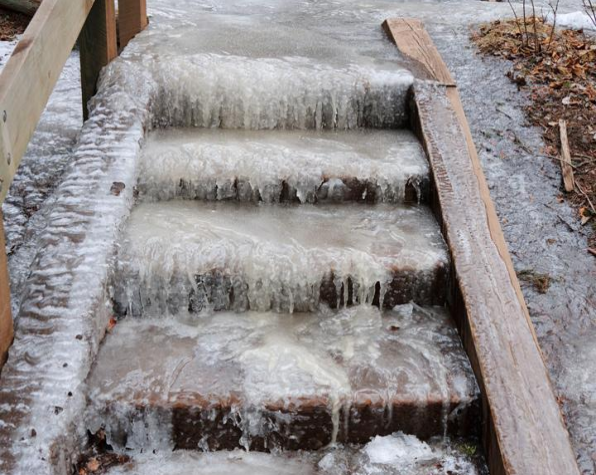Spot The Safety Violation: Keep Outside Areas Clear of Snow & Ice
How safe do you think it would be to try to walk up or down these stairs’

In the winter, you must ensure that outdoor parts of the workplace, such as stairs, sidewalks, parking lots, etc., are clear of snow and ice or treated with sand or de-icer. Snow and ice pose a slip-and-fall hazard to your workers. So like any other safety hazard, under the OHS laws, you must take reasonable steps to protect workers from such slippery surfaces.
The outdoor stairs in this picture are coated with ice and clearly dangerous to anyone trying to navigate them. So the company responsible for the stairs should remove the ice and treat the stairs with de-icer or salt to prevent new ice from forming and/or sand the steps to provide traction for anyone walking on them.
WINTER SLIP-AND-FALL LIABILITY
As noted above, the OHS laws require employers to protect workers from foreseeable hazards. In the winter, snow and ice pose foreseeable slip-and-fall hazards. So you should take reasonable steps to protect them from such hazards, such as having them shovel the snow or spread salt/sand. If you fail to take such steps, you could be liable for a safety offence.
But your possible liability doesn’t end there.
For instance, if another employer’s worker should slip and fall in your parking lot on snow or ice, the related workers’ comp claim costs could be allocated to your workers’ comp record and not the injured worker’s employer.
Example: A worker for a trucking company got out of his truck at another employer’s site, slipped on ice and fell. Workers’ comp covered his injury. But the trucking company said the other employer should be responsible for these costs because the injury was due to its negligence.
The Appeals Commission agreed. It was reasonably foreseeable that a visitor could slip and fall given the weather. So the employer should’ve taken reasonable steps to address the slippery and icy conditions, such as sanding the parking lot. Thus, the Commission concluded that the full costs of the worker’s injury should be transferred to the employer due to its negligence [Decision No: 2012-968, [2012] CanLII 68325 (AB WCAC), Oct. 30, 2012].
Plus, workers aren’t the only ones who could be hurt by snowy or icy surfaces’and the OHS laws aren’t the only laws with which you have to comply.
Visitors to your property could also slip and fall on icy walkways. And under so-called ‘occupiers’ liability’ laws, you could be liable for their injuries, especially if you were aware of the danger.
Example: A man was walking down a public sidewalk in Saskatchewan on his way to a credit union. When he was within a few feet of the credit union’s building, he slipped on a large patch of ice and broke his leg. He sued the credit union for his injuries under the province’s occupiers’ liability law.
The court ruled that the credit union was liable for the man’s broken leg. It explained that, as an occupier of property, the credit union had a duty to use reasonable care to protect visitors from unusual dangers on the property. A downspout at the back of the credit union’s building drained water across the sidewalk, which then froze to create ice. And there was evidence that the credit union knew what was happening and that people had slipped on the ice. Thus, the credit union created a ‘substantial hazard’ on the sidewalk and so was liable for the man’s injuries, ruled the court, ordering the credit union to pay him over $17,000 in damages [Olausen v. Gravelbourg Credit Union Ltd., [1996] S.J. No. 845, Dec. 20, 1996].
That’s one reason why you should have a Visitor Safety Policy.